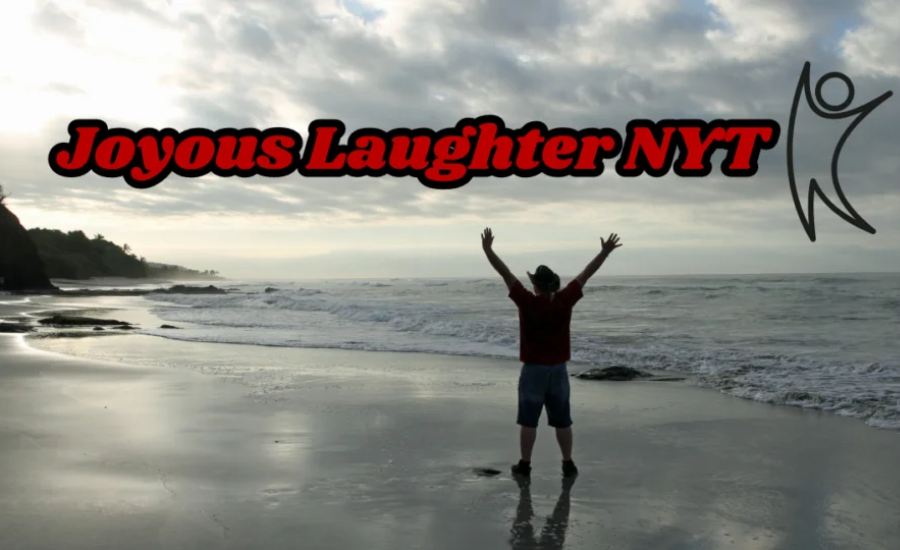The Joy of Laughter: Its Therapeutic Impact and Its Presence in the Joyous Laughter NYT Crossword
Joyous laughter is a vibrant and enriching aspect of our daily lives, infusing our experiences with light and happiness. This concept occasionally appears as a playful challenge in the New York Times Crossword puzzles, adding an extra layer of wit and engagement for enthusiasts. Exploring how joyous laughter is represented in these puzzles—referred to as “joyous laughter NYT crossword”—offers valuable insights into the interplay between language and emotions, enhancing our understanding of both.
Engaging with crossword puzzles featuring joyous laughter is a delightful way to expand our vocabulary and appreciate the subtleties of language. These puzzles not only entertain but also challenge us to think critically about the connections between words and emotions. As we solve clues and unravel the puzzles, we experience the intricate art of language and its power to convey complex feelings such as joy. This process enriches our linguistic skills and deepens our appreciation for the role that such expressions play in literature and everyday conversation.
Understanding and Depicting Joyous Laughter in Culture and Crosswords
Joyous laughter represents a deep expression of amusement, happiness, or relief, characterised by its spontaneous and hearty nature. This form of laughter is often infectious, spreading joy and delight among those who hear it. It transcends mere verbal communication, embodying a powerful emotional release that can uplift and connect people in shared moments of happiness.
In various cultural contexts, joyous laughter is depicted through a range of synonyms and expressions. Terms like “mirth” frequently appear in literature, film, and art, capturing the essence of this lively emotion. This concept is also a notable element in crossword puzzles, including those found in the New York Times Crossword, where clues related to joyous laughter, such as “mirth,” challenge solvers to explore and understand different facets of happiness and amusement.
Engaging with crossword puzzles featuring clues about joyous laughter, or “joyous laughter NYT crossword,” offers a unique opportunity to delve into the subtleties of language and emotion. These puzzles not only provide entertainment but also enhance our appreciation of how joyous laughter is expressed and understood in various contexts. Solving such puzzles can enrich our vocabulary and deepen our grasp of the emotional nuances that make laughter a universal and cherished aspect of human experience.
The New York Times Crossword: Celebrating Joyous Laughter and Its Cultural Significance

The New York Times Crossword has established itself as a cherished daily activity for many, offering a stimulating mental workout with its inventive clues and cultural significance. This esteemed puzzle is celebrated not just for its challenge but also for its ability to reflect and engage with a wide range of themes and ideas, making it a beloved part of daily routines for enthusiasts around the world.
Among the various themes explored in the NYT Crossword, “joyous laughter” is a notable example, often represented by clues that delve into the nuances of happiness. A common clue related to this concept is “Joyous laughter,” which has appeared in the NYT Mini Crossword puzzles. The answer, “MIRTH,” captures a concise yet profound expression of joy, illustrating how a brief moment of happiness can be conveyed through crossword clues.
Incorporating the keyword “joyous laughter NYT crossword,” it becomes evident that such puzzles not only entertain but also enrich our understanding of emotional expressions. By engaging with clues and answers related to joyous laughter, solvers gain insight into how language can encapsulate complex feelings of joy, demonstrating the crossword’s role in both challenging the mind and celebrating the richness of human emotions.
Mastering Crossword Clues on Joyous Laughter
When approaching clues related to joyous laughter in crosswords, it’s essential to delve into the context and underlying meaning of the expression. These clues prompt solvers to reflect on various ways to articulate happiness and amusement, challenging their understanding of both emotional and linguistic nuances. The goal is to identify words that accurately capture the essence of joy and laughter, making it a rewarding intellectual exercise.
To effectively tackle clues about joyous laughter in crosswords, such as those found in the New York Times Crossword, it helps to focus on the number of letters required for the answer. This practical approach guides solvers toward suitable synonyms that align with both the emotional tone and literary context of the clue. By brainstorming terms related to happiness and testing them against the crossword’s constraints, solvers can find the perfect fit for each puzzle.
The keyword “joyous laughter NYT crossword” highlights the connection between understanding emotional expressions and solving crossword puzzles. Employing strategies such as considering synonyms and letter counts not only aids in cracking the clues but also enriches one’s appreciation of how language can convey complex feelings. This process exemplifies the intricate interplay between language and emotion within the realm of crosswords, enhancing both problem-solving skills and emotional insight.
The Health Benefits of Laughter and Its Brain Activity: Insights and Connections

Laughter offers significant benefits for both physical and mental health, acting as a natural remedy to alleviate stress and enhance overall well-being. Engaging in hearty laughter has been shown to reduce levels of stress, boost immune system performance, and provide temporary relief from pain. These effects make laughter a valuable tool for improving both emotional and physical health, contributing to a more balanced and healthier lifestyle.
The positive impact of laughter is supported by various theories related to brain activity. When we laugh, the brain releases endorphins, which are natural chemicals that promote a sense of pleasure and well-being. This biochemical response not only elevates mood but also helps in managing pain and stress, reinforcing the therapeutic value of joyous laughter. Understanding these mechanisms underscores the profound connection between laughter and mental health.
Incorporating the keyword “joyous laughter NYT crossword” into this discussion, we can appreciate how crossword puzzles often highlight the importance of such emotional experiences. Solving clues related to laughter in crosswords not only challenges our linguistic skills but also reflects the broader recognition of laughter’s benefits. By exploring these puzzles, we engage with the positive effects of laughter while enjoying a stimulating intellectual exercise.
Enhancing Personal Resilience Through Laughter
Incorporating laughter into daily life has been shown to significantly enhance personal resilience and coping mechanisms against stress. Many individuals discover that embracing more joyful moments and integrating laughter into their routines helps them navigate challenges more effectively. This personal growth is often attributed to the emotional and psychological benefits that laughter provides, fostering a stronger, more positive outlook.
To make laughter a regular part of your life, consider integrating activities that naturally promote joy and amusement. Engaging in activities such as watching comedies, participating in social gatherings, or practicing laughter yoga can be highly effective. These practices not only offer immediate enjoyment but also contribute to long-term emotional well-being, helping to maintain a balanced and healthy lifestyle.
The keyword “joyous laughter NYT crossword” ties into this discussion by illustrating how crosswords can reflect and celebrate the importance of laughter. Solving crossword clues related to joyous laughter not only provides intellectual stimulation but also highlights the broader appreciation of laughter’s role in enhancing personal resilience and well-being. By making laughter a part of your routine, you embrace its full range of benefits while enjoying the challenge of crosswords.
The Role of Shared Laughter in Relationships and Cultural Variations in Humor
Shared laughter has a profound impact on relationships and social interactions, often serving as a powerful tool for strengthening bonds and creating a positive atmosphere. When people laugh together, it enhances their sense of connection and mutual enjoyment, making social interactions more fulfilling and harmonious. This collective experience fosters a supportive environment, where individuals feel more engaged and connected with one another.
Cultural norms play a significant role in shaping how and when people laugh, reflecting deeper societal values and traditions. Different cultures have varied approaches to laughter, influencing its expression and significance within each society. By exploring how laughter is perceived across cultures, we gain insight into the diverse ways in which joy and amusement are integrated into social practices. Incorporating the keyword “joyous laughter NYT crossword” into this context underscores the broader appreciation of laughter’s role in enhancing both personal relationships and cultural understanding.
Therapeutic and Healing Effects of Laughter
Laughter therapy has become a recognized method in medical settings for enhancing mood and improving overall outlook. This therapeutic approach is employed to help patients manage stress, boost emotional well-being, and foster a more positive attitude. By integrating laughter into treatment plans, healthcare professionals leverage its benefits to support mental health and enhance patients’ quality of life.
Incorporating laughter into workplace and educational environments has proven to be highly beneficial as well. Encouraging moments of humour and light-heartedness can significantly enhance creativity and productivity among teams. Whether through organised laughter sessions or casual, spontaneous humour, fostering a positive atmosphere at work or school contributes to better engagement and more effective problem-solving. The concept of “joyous laughter NYT crossword” reflects this broader understanding, showing how the inclusion of laughter can positively influence various aspects of life, including professional and educational settings.
Challenges and Future Directions in Laughter Research
Studying laughter presents unique challenges, primarily due to its subjective and variable nature. The effects of laughter can differ greatly from person to person, making it difficult to establish consistent measurements and outcomes. This variability complicates research efforts aimed at quantifying laughter’s impact on health and well-being, posing significant obstacles for scientists trying to draw broad conclusions.
Despite these challenges, there is ongoing interest in exploring the deeper effects of laughter on both the brain and body. Researchers are continually investigating how laughter influences various physiological and psychological processes, aiming to uncover more about its potential benefits. This includes studying the complex interactions between laughter and brain function, as well as its overall impact on physical health.
The keyword “joyous laughter NYT crossword” highlights the broader relevance of laughter beyond just its therapeutic aspects. As laughter appears in popular puzzles like the New York Times Crossword, it reflects a widespread recognition of its significance and invites further exploration into its many benefits. Understanding how laughter works and its implications for health remains an exciting area of research with potential for valuable discoveries.
FAQs
Q1. What does “joyous laughter” represent in the context of crossword puzzles?
A. In crossword puzzles, including the NYT Crossword, “joyous laughter” often refers to a term like “mirth,” capturing a deep expression of happiness and amusement. This concept adds a layer of engagement and insight into the interplay between language and emotions.
Q2. How can engaging with crossword clues about joyous laughter enhance our understanding of language?
A. Solving clues related to joyous laughter in crosswords challenges our vocabulary and appreciation of emotional expressions. It helps us explore and understand the subtle connections between words and the complex feelings they convey.
Q3. What are the therapeutic benefits of laughter?
A. Laughter offers significant benefits, including stress reduction, improved immune function, and temporary pain relief. It also triggers the release of endorphins, which promote overall well-being and elevate mood.
Q4. How does laughter contribute to personal resilience?
A. Incorporating laughter into daily routines can enhance personal resilience by improving mood and coping mechanisms against stress. Activities like watching comedies or practising laughter yoga contribute to long-term emotional well-being.
Q5. What challenges are faced in laughter research?
A. Laughter research faces challenges due to its subjective and variable nature, making it difficult to measure its effects consistently. Despite these challenges, ongoing research aims to explore the deeper impact of laughter on health and brain function.
Conclusion
Joyous laughter is a vital part of our daily lives, infusing our experiences with happiness and lightness. It appears in crosswords like the NYT Crossword as a playful challenge, enhancing our understanding of language and emotion. Engaging with such puzzles not only entertains but also deepens our appreciation for the emotional nuances of laughter. Beyond puzzles, laughter contributes significantly to both physical and mental health, offering therapeutic benefits and enhancing personal resilience. While research continues to explore its complexities, laughter’s role in enriching our lives and connections remains evident and impactful.
Read More: England Tribune





